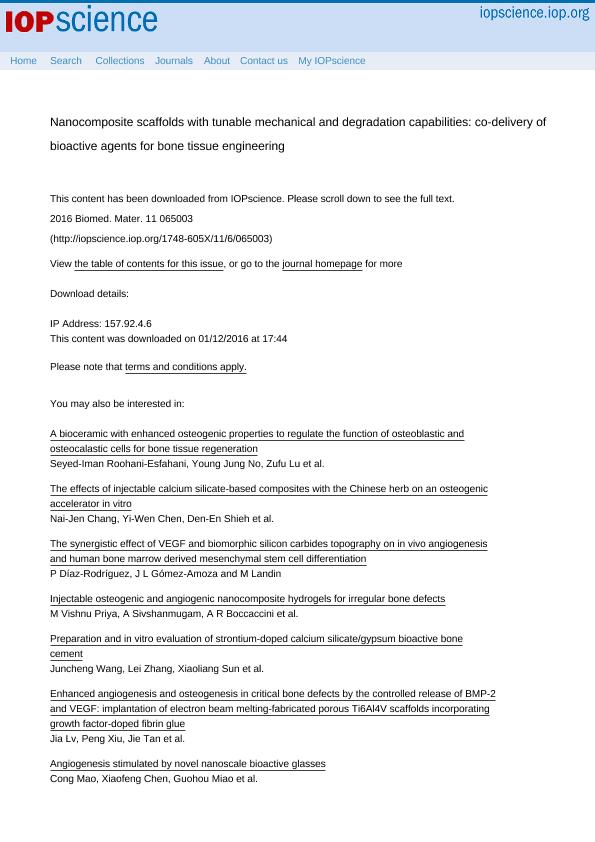Mostrar el registro sencillo del ítem
dc.contributor.author
Cattalini, Juan Pablo

dc.contributor.author
Roether, Judith A.

dc.contributor.author
Hoppe, Alexander
dc.contributor.author
Pishbin, Fatemeh
dc.contributor.author
Haro Durand, Luis Alberto

dc.contributor.author
Gorustovich Alonso, Alejandro Adrian

dc.contributor.author
Boccaccini, Aldo R.

dc.contributor.author
Lucangioli, Silvia Edith

dc.contributor.author
Mouriño, Viviana Silvia Lourdes

dc.date.available
2018-03-23T22:03:03Z
dc.date.issued
2016-10
dc.identifier.citation
Cattalini, Juan Pablo; Roether, Judith A.; Hoppe, Alexander; Pishbin, Fatemeh; Haro Durand, Luis Alberto; et al.; Nanocomposite scaffolds with tunable mechanical and degradation capabilities: Co-delivery of bioactive agents for bone tissue engineering; IOP Publishing; Biomedical Materials; 11; 6; 10-2016; 1-14
dc.identifier.issn
1748-6041
dc.identifier.uri
http://hdl.handle.net/11336/39869
dc.description.abstract
Novel multifunctional nanocomposite scaffolds made of nanobioactive glass and alginate crosslinked with therapeutic ions such as calcium and copper were developed for delivering therapeutic agents, in a highly controlled and sustainable manner, for bone tissue engineering. Alendronate, a well-known antiresorptive agent, was formulated into microspheres under optimized conditions and effectively loaded within the novel multifunctional scaffolds with a high encapsulation percentage. The size of the cation used for the alginate crosslinking impacted directly on porosity and viscoelastic properties, and thus, on the degradation rate and the release profile of copper, calcium and alendronate. According to this, even though highly porous structures were created with suitable pore sizes for cell ingrowth and vascularization in both cases, copper-crosslinked scaffolds showed higher values of porosity, elastic modulus, degradation rate and the amount of copper and alendronate released, when compared with calcium-crosslinked scaffolds. In addition, in all cases, the scaffolds showed bioactivity and mechanical properties close to the endogenous trabecular bone tissue in terms of viscoelasticity. Furthermore, the scaffolds showed osteogenic and angiogenic properties on bone and endothelial cells, respectively, and the extracts of the biomaterials used promoted the formation of blood vessels in an ex vivo model. These new bioactive nanocomposite scaffolds represent an exciting new class of therapeutic cell delivery carrier with tunable mechanical and degradation properties; potentially useful in the controlled and sustainable delivery of therapeutic agents with active roles in bone formation and angiogenesis, as well as in the support of cell proliferation and osteogenesis for bone tissue engineering.
dc.format
application/pdf
dc.language.iso
eng
dc.publisher
IOP Publishing

dc.rights
info:eu-repo/semantics/openAccess
dc.rights.uri
https://creativecommons.org/licenses/by-nc-sa/2.5/ar/
dc.subject
Alendronate Delivery
dc.subject
Bone Tissue Engineering
dc.subject
Controlled And Sustainable Release
dc.subject
Ions
dc.subject
Nanocomposite Scaffolds
dc.subject.classification
Otras Ingeniería de los Materiales

dc.subject.classification
Ingeniería de los Materiales

dc.subject.classification
INGENIERÍAS Y TECNOLOGÍAS

dc.subject.classification
Otras Ingeniería Médica

dc.subject.classification
Ingeniería Médica

dc.subject.classification
INGENIERÍAS Y TECNOLOGÍAS

dc.subject.classification
Otras Ciencias de la Salud

dc.subject.classification
Ciencias de la Salud

dc.subject.classification
CIENCIAS MÉDICAS Y DE LA SALUD

dc.title
Nanocomposite scaffolds with tunable mechanical and degradation capabilities: Co-delivery of bioactive agents for bone tissue engineering
dc.type
info:eu-repo/semantics/article
dc.type
info:ar-repo/semantics/artículo
dc.type
info:eu-repo/semantics/publishedVersion
dc.date.updated
2018-03-20T14:35:21Z
dc.journal.volume
11
dc.journal.number
6
dc.journal.pagination
1-14
dc.journal.pais
Reino Unido

dc.journal.ciudad
Londres
dc.description.fil
Fil: Cattalini, Juan Pablo. Universidad de Buenos Aires. Facultad de Farmacia y Bioquímica. Departamento de Tecnología Farmacéutica; Argentina
dc.description.fil
Fil: Roether, Judith A.. Universitat Erlangen-Nuremberg; Alemania
dc.description.fil
Fil: Hoppe, Alexander. Universitat Erlangen-Nuremberg; Alemania
dc.description.fil
Fil: Pishbin, Fatemeh. Imperial College London; Reino Unido
dc.description.fil
Fil: Haro Durand, Luis Alberto. Consejo Nacional de Investigaciones Científicas y Técnicas; Argentina
dc.description.fil
Fil: Gorustovich Alonso, Alejandro Adrian. Consejo Nacional de Investigaciones Científicas y Técnicas; Argentina
dc.description.fil
Fil: Boccaccini, Aldo R.. Universitat Erlangen-Nuremberg; Alemania
dc.description.fil
Fil: Lucangioli, Silvia Edith. Universidad de Buenos Aires. Facultad de Farmacia y Bioquímica. Departamento de Tecnología Farmacéutica; Argentina. Consejo Nacional de Investigaciones Científicas y Técnicas; Argentina
dc.description.fil
Fil: Mouriño, Viviana Silvia Lourdes. Universidad de Buenos Aires. Facultad de Farmacia y Bioquímica. Departamento de Tecnología Farmacéutica; Argentina. Consejo Nacional de Investigaciones Científicas y Técnicas; Argentina
dc.journal.title
Biomedical Materials

dc.relation.alternativeid
info:eu-repo/semantics/altIdentifier/doi/http://dx.doi.org/10.1088/1748-6041/11/6/065003
dc.relation.alternativeid
info:eu-repo/semantics/altIdentifier/url/http://iopscience.iop.org/article/10.1088/1748-6041/11/6/065003/meta
Archivos asociados
